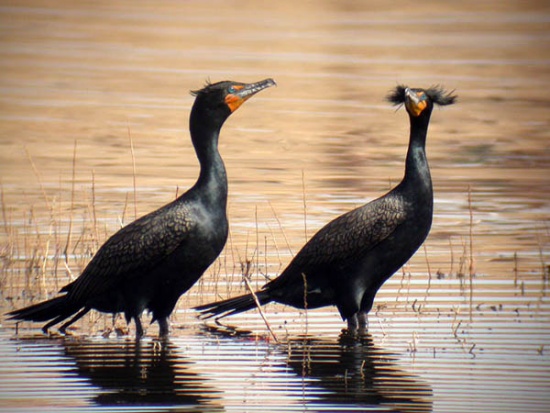m |
|||
| Line 1: | Line 1: | ||
;Phalacrocorax auritus | ;Phalacrocorax auritus | ||
| − | [[Image:Double-crested_Cormorant.jpg|thumb| | + | [[Image:Double-crested_Cormorant.jpg|thumb|550px|right|Photo by Steve Messick<br>Photographed: St. Vrain SWA, Weld County Colorado |
| + | ]] | ||
| + | |||
==Identification== | ==Identification== | ||
| − | + | The Double-crested Cormorant is a large black bird 74–91 cm (29"–36") long, with a wingspan up to 132 cm (52"). It has a long tail and a yellow throat-patch, and can appear to have a green sheen in certain lighting. The white double head crest is seen for a short period during the breeding season in western birds; it is duller in eastern birds. Juveniles are brown with a white face, foreneck, and breast. | |
| + | ==Distribution== | ||
| + | A very common and widespread species, it winters anywhere that is ice-free along both coasts, as far north as southern Alaska (on the west coast) and southern New England (on the east coast). It can be found as far south as Mexico and the Bahamas. It migrates from the coldest parts of its breeding range, such as eastern Canada, and has occurred in Europe as a very rare vagrant, for example in Great Britain, Ireland and the Azores. | ||
| + | ==Taxonomy== | ||
| + | The Double-crested Cormorant (Phalacrocorax auritus) is a member of the cormorant family of seabirds. | ||
| + | ==Habitat== | ||
| + | ==Behaviour== | ||
| + | The Double-crested Cormorant swims low in the water, often with just its neck and head visible, and dives from the surface. It uses its feet for propulsion and is able to dive to a depth of 1.5–7.5 m (5–25 feet) for 30–70 seconds. After diving, it spends long periods standing with its wings outstretched to allow them to dry, since they are not fully waterproofed. This species flies low over the water, with its bill tilted slightly upward, sometimes leaving the colony in long, single-file lines. | ||
==External Links== | ==External Links== | ||
*[http://www.birdforum.net/pp_gallery/showgallery.php?mcats=all&what=allfields&si=Phalacrocorax+auritus View more images of Double-crested Cormorant in the gallery] | *[http://www.birdforum.net/pp_gallery/showgallery.php?mcats=all&what=allfields&si=Phalacrocorax+auritus View more images of Double-crested Cormorant in the gallery] | ||
[[Category:Birds]] | [[Category:Birds]] | ||
Revision as of 20:53, 14 July 2007
- Phalacrocorax auritus
Identification
The Double-crested Cormorant is a large black bird 74–91 cm (29"–36") long, with a wingspan up to 132 cm (52"). It has a long tail and a yellow throat-patch, and can appear to have a green sheen in certain lighting. The white double head crest is seen for a short period during the breeding season in western birds; it is duller in eastern birds. Juveniles are brown with a white face, foreneck, and breast.
Distribution
A very common and widespread species, it winters anywhere that is ice-free along both coasts, as far north as southern Alaska (on the west coast) and southern New England (on the east coast). It can be found as far south as Mexico and the Bahamas. It migrates from the coldest parts of its breeding range, such as eastern Canada, and has occurred in Europe as a very rare vagrant, for example in Great Britain, Ireland and the Azores.
Taxonomy
The Double-crested Cormorant (Phalacrocorax auritus) is a member of the cormorant family of seabirds.
Habitat
Behaviour
The Double-crested Cormorant swims low in the water, often with just its neck and head visible, and dives from the surface. It uses its feet for propulsion and is able to dive to a depth of 1.5–7.5 m (5–25 feet) for 30–70 seconds. After diving, it spends long periods standing with its wings outstretched to allow them to dry, since they are not fully waterproofed. This species flies low over the water, with its bill tilted slightly upward, sometimes leaving the colony in long, single-file lines.




